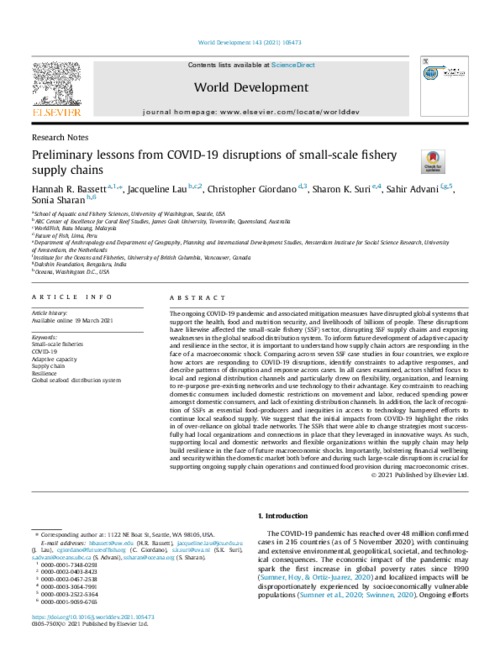Preliminary lessons from COVID-19 disruptions of small-scale fishery supply chains

The ongoing COVID-19 pandemic and associated mitigation measures have disrupted global systems that support the health, food and nutrition security, and livelihoods of billions of people. These disruptions have likewise affected the small-scale fishery (SSF) sector, disrupting SSF supply chains and exposing weaknesses in the global seafood distribution system. To inform future development of adaptive capacity and resilience in the sector, it is important to understand how supply chain actors are responding in the face of a macroeconomic shock. Comparing across seven SSF case studies in four countries, we explore how actors are responding to COVID-19 disruptions, identify constraints to adaptive responses, and describe patterns of disruption and response across cases. In all cases examined, actors shifted focus to local and regional distribution channels and particularly drew on flexibility, organization, and learning to re-purpose pre-existing networks and use technology to their advantage. Key constraints to reaching domestic consumers included domestic restrictions on movement and labor, reduced spending power amongst domestic consumers, and lack of existing distribution channels. In addition, the lack of recognition of SSFs as essential food-producers and inequities in access to technology hampered efforts to continue local seafood supply. We suggest that the initial impacts from COVID-19 highlight the risks in of over-reliance on global trade networks. The SSFs that were able to change strategies most successfully had local organizations and connections in place that they leveraged in innovative ways. As such, supporting local and domestic networks and flexible organizations within the supply chain may help build resilience in the face of future macroeconomic shocks. Importantly, bolstering financial wellbeing and security within the domestic market both before and during such large-scale disruptions is crucial for supporting ongoing supply chain operations and continued food provision during macroeconomic crises.